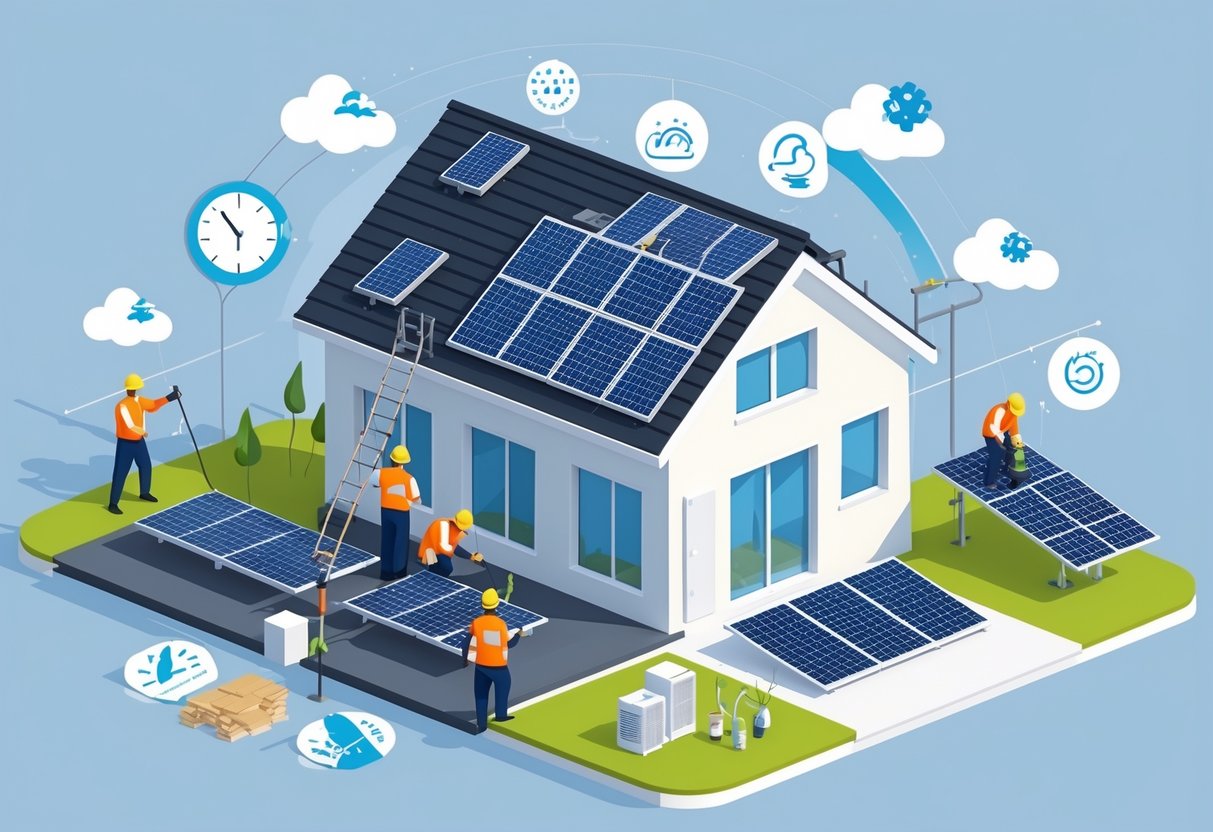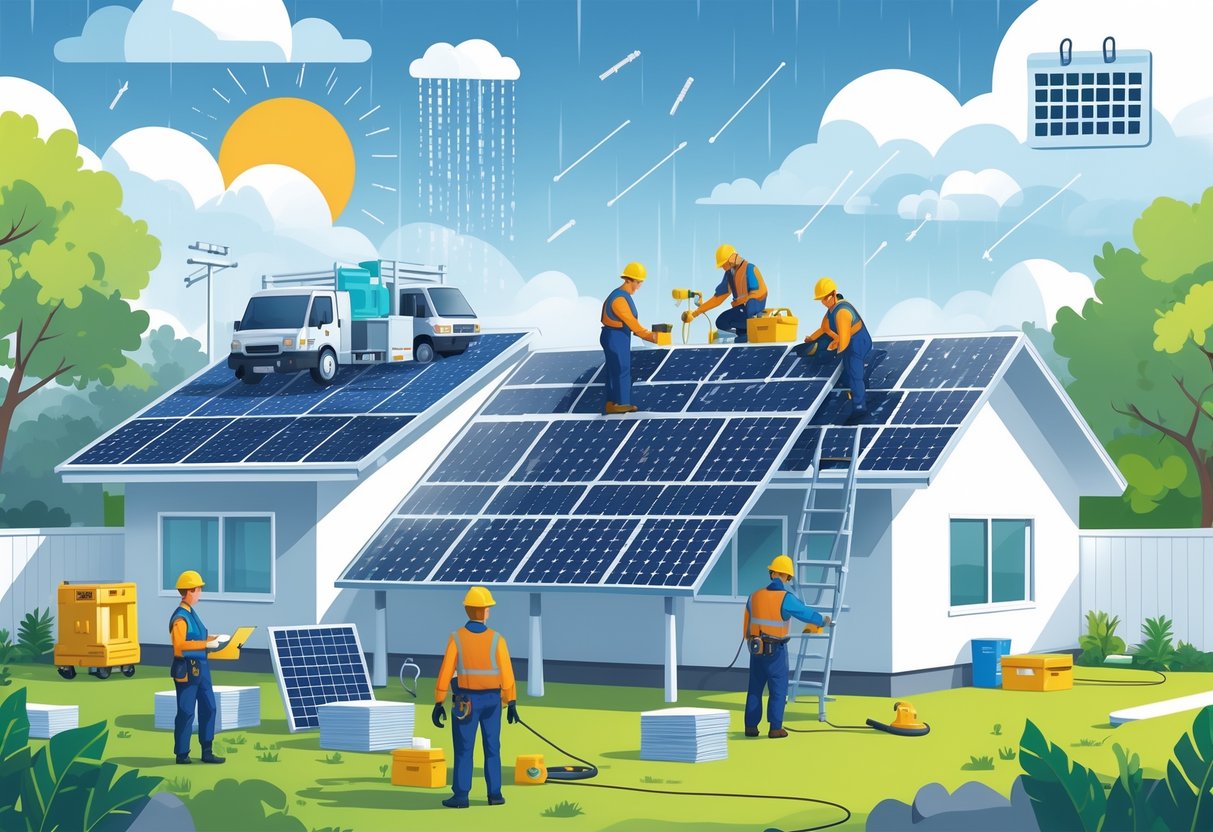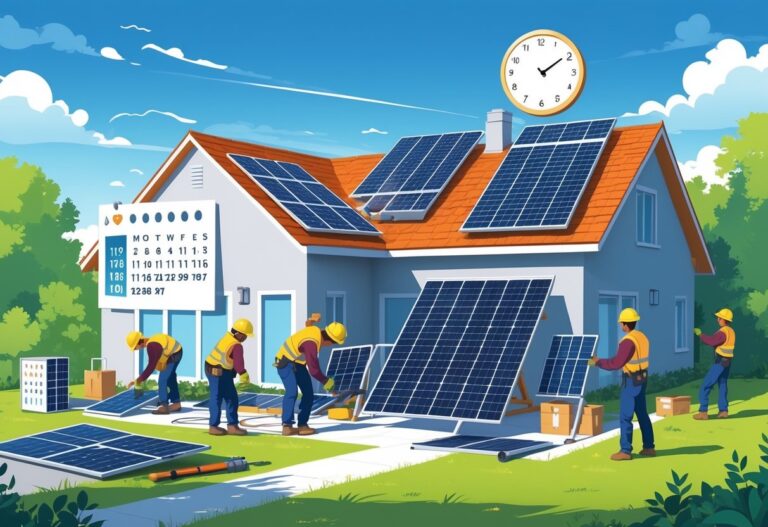Ever wondered how long it really takes to get solar panels up and running at home? Most people find the whole process takes anywhere from a few weeks to a couple of months, depending on system size, local permits, and how busy your installer is.
Honestly, the actual install is usually just a day or two. But paperwork, inspections, and waiting on utility approvals? That’s where the real waiting happens.

Every solar job goes through a handful of steps: site evaluation, design, permitting, installation, and then finally, turning everything on. If your roof is unusual, the weather isn’t cooperating, or your installer’s backed up, things can drag out.
If you’re curious about the nitty-gritty of what slows things down, EnergySage has a pretty detailed guide on how long it takes to install solar panels.
Need a Home Fix – Emergency or Routine?
From leaks and no-heat nights to simple tune-ups, our 24/7 hotline connects you with trusted local pros in minutes.
Key Takeaways
- Average installation process takes a few weeks to a couple of months
- Permits and approvals can add time beyond the actual panel installation
- Home and project details impact how long the timeline will be
Average Time Frame for Solar Installations
Usually, a full solar installation takes anywhere from several weeks up to a few months. The timeline depends a lot on the type and size of the system you’re putting in.
There’s a pretty big difference between residential and commercial projects, and even between roof-mounted and ground-mounted systems. Each has its own rhythm.
Typical Residential Installation Duration
For most homes, you’ll go through seven main steps: site assessment, system design, permits, ordering equipment, installation, inspection, and finally, connecting to the grid. Each step can add a bit of time.
From the first chat with your installer to flipping the switch, residential solar usually takes 1 to 3 months. The actual rooftop work? That’s often just 1 to 3 days.
Waiting for permits and inspections tends to eat up the most time. Some cities are quick—done in a week. Others? You might be waiting for weeks. There’s a more detailed breakdown in this solar installation timeline guide if you want specifics.
Commercial Project Timelines
Commercial solar is a different beast. Smaller business installs might wrap up in 2 to 4 months, but big projects can stretch out to 6 months or even longer.
Why? There’s just more to juggle—detailed site checks, more engineering, city permits, and sometimes even soil testing. Plus, utility approvals can get complicated.
Ordering equipment for commercial jobs can take longer, especially if custom parts are needed. And inspections? You might see more than one agency stopping by.
Timeline Comparison: Roof-Mounted vs. Ground-Mounted Systems
Roof-mounted systems are the go-to for most homes, and they’re usually faster. The rooftop work can be done in just a few days, but you’re often waiting on permits and utility company schedules.
Ground-mounted systems need more prep. Crews have to clear land, dig trenches for cables, and pour concrete for the mounts. All that extra work can tack on days or even weeks.
So, if you’re thinking about ground mounts, expect the process to be on the longer side. There’s a good breakdown at Solaratics’ page on installation times if you want to dig deeper.
Key Phases of the Solar Installation Process
Installing solar panels isn’t just about putting hardware on your roof. There are a few important steps, and each one affects how soon your system will be ready to use.
Site Assessment and Initial Consultation
First up is the site assessment. A solar pro comes over to check your roof—how it faces, its angle, and whether it’s strong enough.
They’ll also look for shade from trees or other buildings and take some measurements and photos. It’s a pretty thorough visit.
During this meeting, you’ll talk about your energy use, goals, and budget. The company might walk you through incentives and financing options.
This part usually takes a week or two. It’s a crucial step because a good assessment means fewer headaches later.
System Design and Engineering
Once they’ve seen your place, the solar company starts designing your system. They’ll figure out how many panels you need, what kind, and exactly where everything will go.
Engineers use the info from the site visit to make sure the design fits your roof and meets local codes. They’ll draw up plans showing panel layout, wiring, and inverter placement.
Sometimes, the design needs a review inside the company, and changes might be made. This usually takes 2-3 weeks, though tricky roofs or big systems can take longer.
Permitting and Regulatory Approval
Before anything gets installed, you need permits. The solar company will handle the paperwork and send plans to the city or county. Sometimes, you’ll need HOA or historic district approval too.
Permitting is often the slowest part. It can take anywhere from 2 to 7 weeks, depending on your local government and how busy they are. If your plans need changes, that can drag things out.
You can’t skip this step, so it’s smart to plan for delays. More details on the process are at Gecko Solar Energy.
Equipment Procurement
After permits come through, it’s time to order your gear. The solar company arranges for panels, inverters, and mounting hardware to be delivered.
If your equipment is standard, it usually arrives quickly. Special orders or supply hiccups can add a week or more.
Most installers won’t set an install date until everything’s on site. Good communication with suppliers helps keep things on track.
Usually, this phase is wrapped up in a week or two if there aren’t any backorders.
Installation Day and Activation
Most homes see their solar panels installed and wired in about one to three days. The main job is mounting the panels, running wires, and getting the green light to flip the switch.
If your project is simple, it might be even faster. Complicated roofs or big systems can take a little longer.
Physical Installation Procedures
Installers start by prepping your roof and putting up supports or rails. They need to get everything lined up and anchored so the panels stay put, no matter the weather.
Once the supports are up, panels are brought up and attached with brackets. The crew checks spacing so the panels work efficiently and can be serviced later if needed.
Safety is a big deal—expect to see harnesses and helmets, especially on steep roofs. Most residential jobs finish in a day or two, but tougher installs can stretch to three days. There’s a handy homeowner’s guide to solar installation if you want to know what to expect.
Electrical Work and System Integration
With panels in place, it’s time to hook up the wiring. Installers connect each panel, usually in series or parallel, and run those wires to an inverter.
The inverter, which turns DC into AC, is often installed near your breaker panel or in the garage. There’s always a safety shutoff added, just in case.
All wiring gets enclosed in conduit to meet code. Technicians check everything with meters to make sure it’s safe and grounded properly.
Once they’re done, your home’s electrical panel is ready to pull power from the sun.
Inspection and Utility Interconnection
After everything’s installed, a building inspector comes by. They’ll check the mounting, wiring, and equipment to make sure it’s all up to code. This inspection is required before you can turn things on.
Once you pass, the utility company steps in. Sometimes they need to swap in a new electric meter or install monitoring gear.
The last step is getting “permission to operate.” Only then can you turn the system on. This final round of approvals can take anywhere from a few days to several weeks, depending on your area. There’s more info in the solar panel installation timeline.
Factors Influencing Installation Time

How long solar takes isn’t set in stone. It depends on a bunch of things—house size, legal hoops, weather, and more. Sometimes it’s smooth, sometimes not so much.
Project Size and Complexity
System size is probably the biggest factor. A small rooftop setup on a typical house? That’s often done in 1 to 3 days. Larger homes or systems with more panels, tricky wiring, or batteries will take longer.
Complex roofs—steep, really high, or with lots of angles—need extra safety steps and special mounts. That adds time, too.
Commercial projects are a different story. Big buildings mean more gear and more steps, so installs can stretch to a week or more. Every extra panel or fancy add-on is another task. If you want to see how project size changes the timeline, check out this overview of solar panel installation factors.
Local Permitting Requirements
Permits and local rules are a classic source of headaches and delays. Solar installers have to stick to city and county codes, which usually means chasing down multiple permits before anything else can happen.
Some places make this easy with quick approvals. Others? You might be stuck waiting for weeks, sometimes even months, just to get a green light.
Some areas also demand a site inspection or utility approval before you can flip the switch. Waiting for these final checks can drag out even a straightforward job.
These steps, while sometimes annoying, do matter for safety and to keep everything above board. If you want to get into the weeds on permits, take a look at this guide on installation time.
Weather and Site Conditions
Weather can throw a wrench into solar installs. Heavy rain, high winds, or snowstorms? Crews can’t safely work on roofs in those conditions.
Even extreme heat or freezing days can cut work hours or force the team to reschedule. You never really know what you’ll get.
Roof condition is another biggie. If your roof needs repairs or has hidden issues, expect extra work and extra time.
Obstacles like tree branches or satellite dishes can also slow things down if they need to be moved first.
Crews usually plan around forecasts, but surprise storms still happen. Mild, dry weather is always the dream for speedy installs—more on that in this breakdown of installation time factors.
Typical Delays and How to Minimize Them

Delays in solar installations? They’re more common than you’d hope, but most of them can be dodged with a bit of planning and a few smart moves.
Supply Chain and Equipment Delays
Solar projects depend on things like panels, inverters, batteries, and mounting gear. Shipments can get held up because of global supply chain hiccups, shortages, or shipping slowdowns.
Raw material shortages or factory closures can make you wait weeks for certain parts. It’s frustrating, but it happens.
One way to avoid this? Ask your installer about equipment availability before you sign anything. Standard products that are kept in stock are usually less risky than custom or special-order gear.
Good installers will give you honest timelines and let you know if something’s running late. Some even offer swaps for similar equipment if your first choice is backordered.
If you want to dig deeper, here’s a handy guide to reducing project delays in solar installations.
Scheduling and Contractor Availability
Getting a skilled solar crew is half the battle. Delays often pop up because demand is high, there aren’t enough workers, or the contractor’s schedule is just packed.
Sometimes, the good crews are booked out weeks in advance, so your project gets bumped down the list.
If you want to dodge this, try to schedule your install early—off-peak seasons like fall or winter are usually less hectic. Companies with in-house teams (not just subcontractors) can also be more reliable with scheduling.
Clear communication about timelines helps too. Pick a company with solid reviews and a track record for finishing on time, and you’ll save yourself a lot of waiting.
Addressing Inspection or Permitting Issues
Solar installs need stamps of approval from local authorities before and after the work. Sometimes, there’s a backlog because of too many requests or not enough staff—especially in busy areas.
Working with an installer who knows the ropes can speed things up. They should handle the paperwork and double-check forms for errors—little mistakes can mean weeks of extra waiting.
Some companies get ahead by scheduling site visits early and keeping paperwork organized. Keeping tabs on your application status and staying in touch with the permitting office can help you dodge nasty surprises.
If things drag on, ask your installer if you can start parts of the work in stages. There’s more on this in this article on reducing solar installation delays in 2025.
Post-Installation Timeline
After the panels are up, there’s still a bit more to do before you’re running at full power. These last steps make sure everything’s safe, legal, and ready for daily use.
Testing and Final Approval
Once everything’s installed, your installer will run a bunch of tests. They’ll check electrical connections, make sure the inverter settings are right, and confirm that power is flowing safely.
Usually, a local inspector or utility official has to sign off before you can turn the system on. Depending on the area, this inspection can happen in a few days or take a couple of weeks.
After that, the utility gives you “permission to operate” (PTO). Only then can you connect to the grid and start making power.
Getting this final approval can add another week or three to your timeline. If you want more specifics, check out this solar installation timeline guide.
System Monitoring Setup
System monitoring is pretty handy for tracking your energy production and catching issues early. Installers usually set up an online dashboard or app that shows real-time output and daily numbers.
Most systems use the inverter’s built-in software, paired with Wi-Fi or cellular connections. The installer will help you connect and walk you through using the monitoring tools.
This is usually wrapped up within a day after you get PTO. Monitoring’s important because it tells you if your system is actually working as it should—and if it’s not, you’ll know right away.
Customer Support and Maintenance Scheduling
Good solar companies don’t disappear once the job’s done. They’ll give you contact info for questions, troubleshooting, or warranty help.
Installers might schedule your first annual checkup or cleaning, but honestly, most solar panels don’t need much regular maintenance. Still, it’s nice to know help is there if you need it.
Keep your important docs and support numbers somewhere easy to find. Having a responsive company makes life way easier if anything pops up down the line.
Understanding Timelines by Region
How long does it take to get solar installed? It really depends on where you live. Local rules, climate, and utility processes all play a part.
Some places breeze through permits and inspections. Others? Not so much. Strict codes or high demand can really slow things down.
Here’s a quick look at average timelines by area:
| Region Type | Typical Timeline |
|---|---|
| Urban | 2-4 months |
| Suburban | 2-5 months |
| Rural | 3-6 months |
Urban areas might have faster permit offices, but they’re often crowded. Suburban regions usually see moderate wait times.
For rural locations, it can take longer to get inspections or for installers to make the trip out. Utility approval is sometimes slower too, especially where solar isn’t as common.
Some states move fast—California cities, for example, can be done in a few weeks. Others, especially places new to solar, might drag on for months. More on regional differences at this solar installation timeline resource.
Here are a few things that affect the wait:
- How fast local permits get processed
- Utility company connection times
- Installer backlogs
- Seasonal weather delays
Best bet? Ask local installers about what’s typical in your area. They usually know which steps take the longest and where things can get stuck.
Conclusion
Solar panel installs usually take anywhere from 1 to 3 months, start to finish. The actual hands-on installation is much quicker—often just 1 to 3 days. Most of the wait is tied up in design, permits, and inspections.
Here’s a quick summary:
| Phase | Estimated Time |
|---|---|
| Site Assessment | 1 week |
| Design & Permitting | 2-8 weeks |
| Installation | 1-3 days |
| Inspections/Activation | 1-2 weeks |
Residential jobs are usually done quicker than big commercial projects. Most slowdowns happen during permitting or while waiting for inspections.
Main factors that affect your timeline:
- Local permit rules
- Utility company steps
- Weather or supply chain hiccups
If you stay in touch with your installer and respond quickly when they need info, you can avoid a lot of delays. For a speedier process, check out this step-by-step installation guide.
Every install is its own beast, but most homeowners should expect the whole thing to take several weeks to a few months. That time is what makes sure your system is safe, legal, and ready to start making electricity.
Frequently Asked Questions
The actual install for solar panels can be just a few days, but the whole journey—permits, inspections, and all—can stretch into months. Your roof, your location, and your project size all play a part in how long it’ll take.
What is the typical timeframe for installing residential solar panel systems?
Physically putting panels on your roof usually takes 1 to 3 days. But if you count permits, inspections, and utility sign-offs, expect the whole thing to run two to six months. Delays mostly come from paperwork or waiting on local authorities. You can get more details at How Long Does a Solar Panel Installation Take?
How many days are required for a commercial solar panel setup to be fully operational?
Commercial projects take longer than residential ones. The install itself can last a few weeks, depending on the system and building. With design, permits, and inspections, a commercial job can easily take several months before it’s up and running.
What factors influence the duration of a school’s solar panel installation process?
Lots of things affect a school solar install: project size, building age, permit and inspection waits, weather, and even school schedules. Sometimes, custom engineering or extra safety rules add more time.
Upon installation, how soon will newly installed solar panels begin producing energy?
Panels can start making power as soon as they’re hooked up and the utility signs off. Sometimes, that’s right after the final inspection. Other times, you might have to wait a bit for formal “permission to operate” from the utility. More info here: How Long Does Solar Installation Take?
Is there a difference in installation time between mounting solar panels on various roof types?
Yeah, roof type actually matters. Mounting solar panels on flat or metal roofs usually goes quicker since there’s less prep work involved.
But if your roof’s got sharp angles, lots of stuff in the way, or it’s made from older materials, expect it to take longer. Installers have to be extra careful and sometimes need more materials for those tricky spots.
What are the average work hours for solar installers during a project?
Solar installers usually keep to standard construction hours, so think 8 a.m. to 5 p.m. most days. That said, shifts can change a bit depending on the weather, project size, or even where the job is.
Most crews stick with it until the system’s actually in place. The schedule’s planned with safety and efficiency in mind, but there’s always a little wiggle room for real life.







Leave a Reply